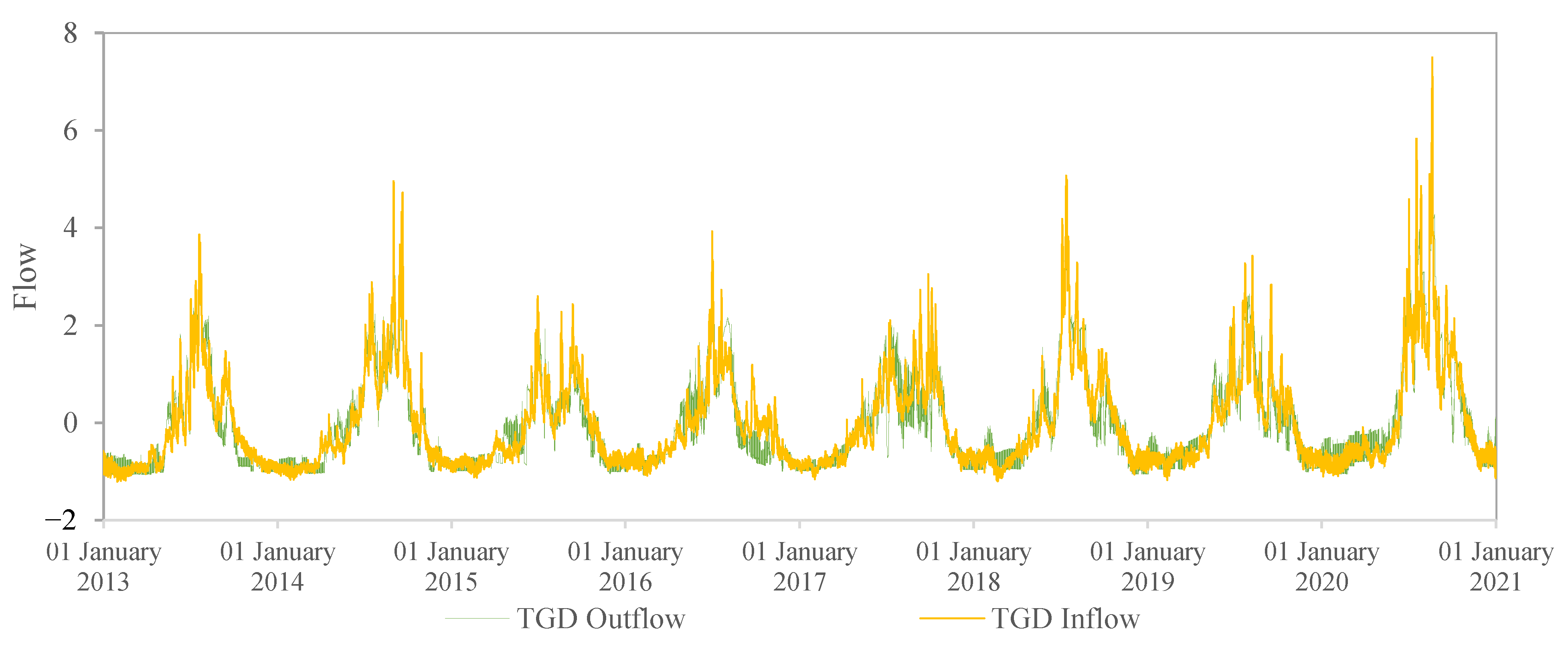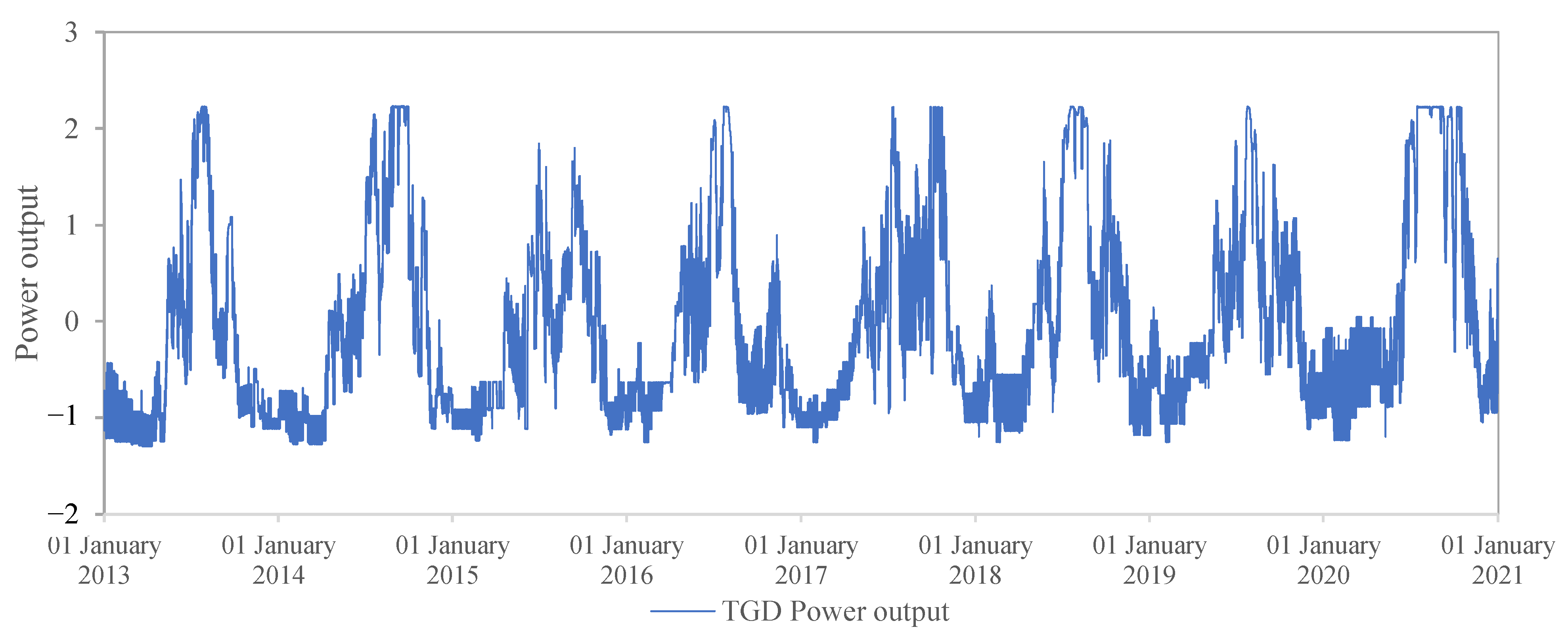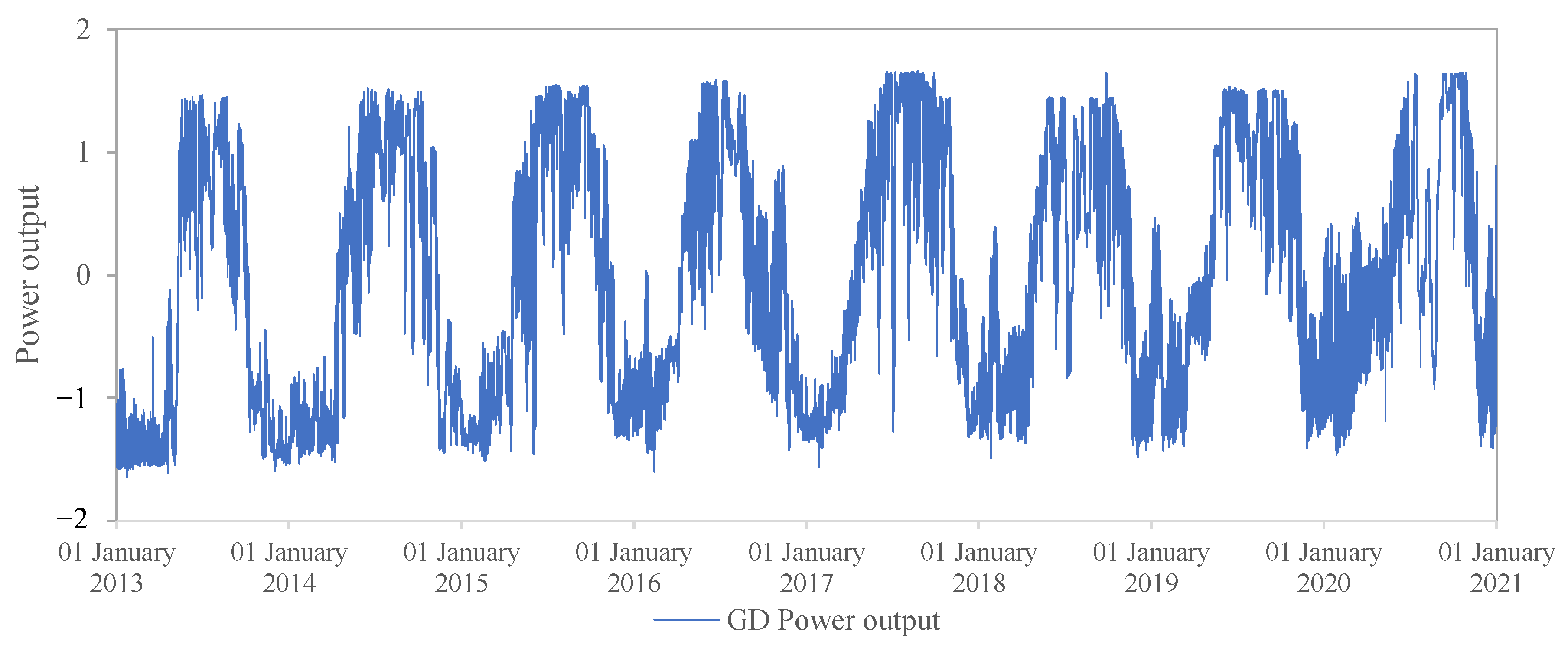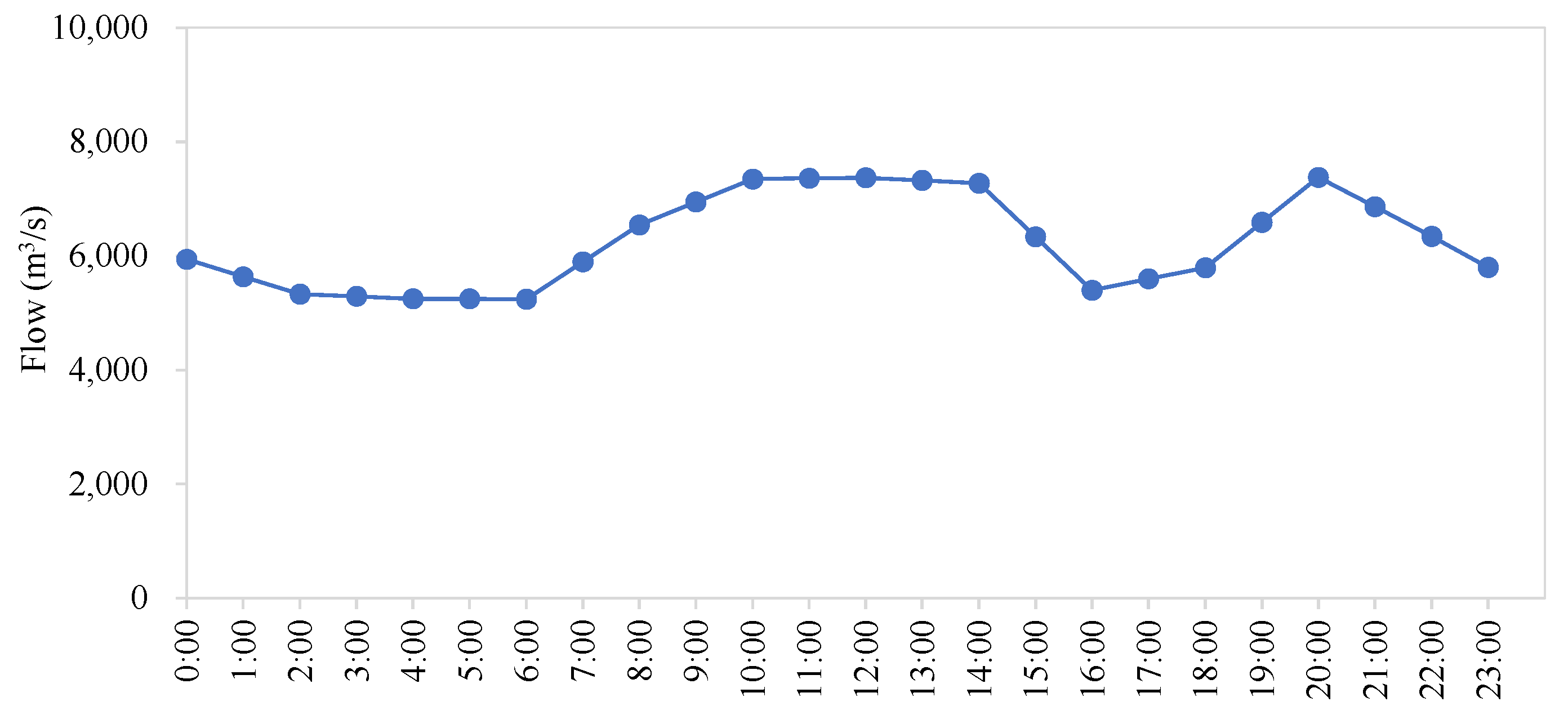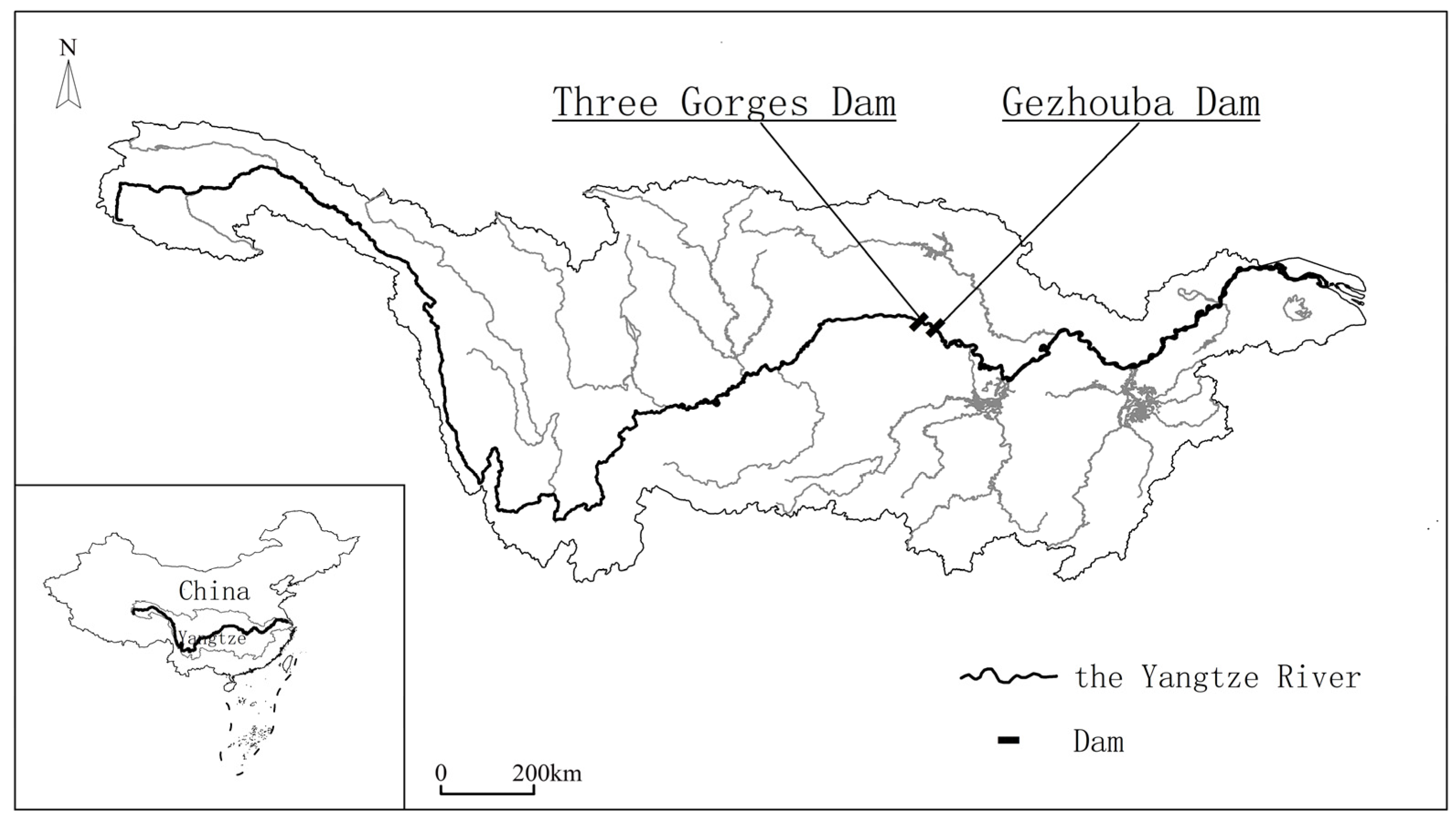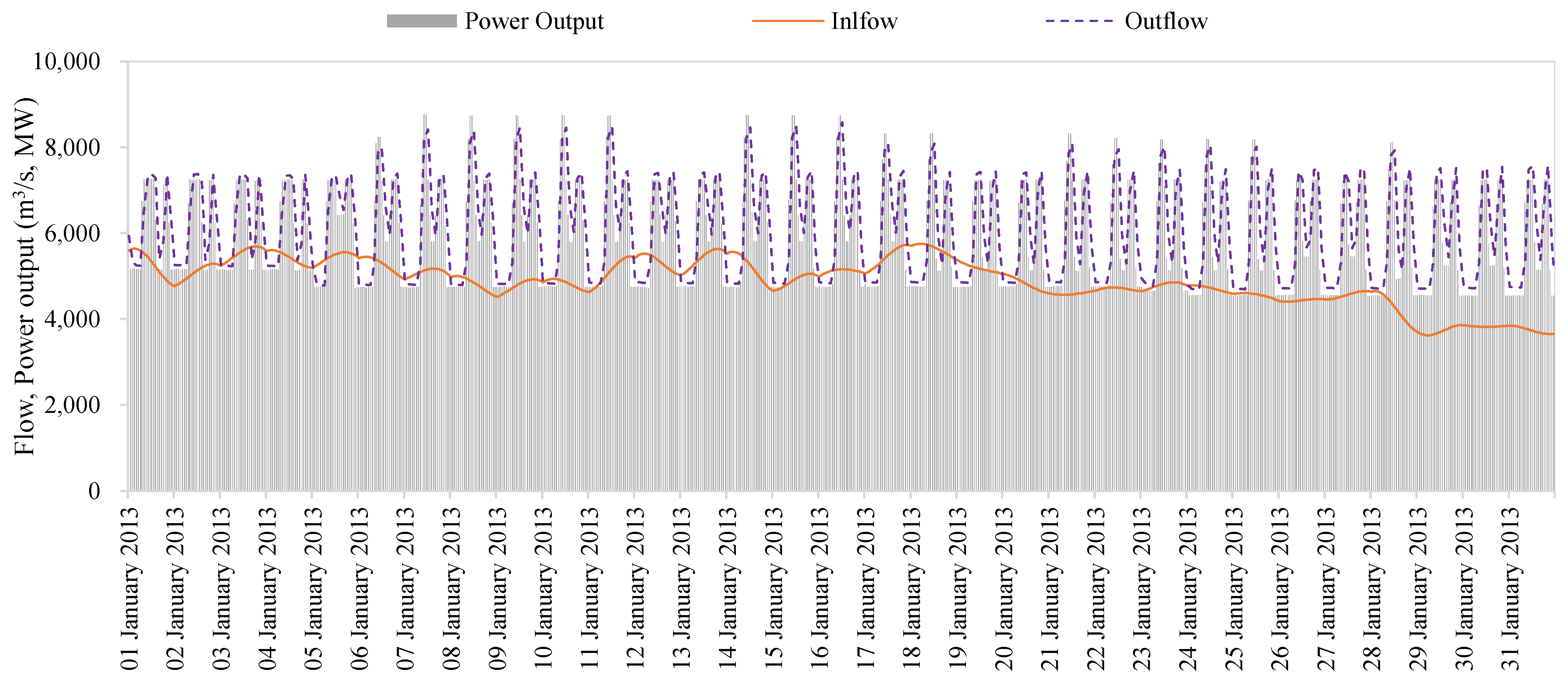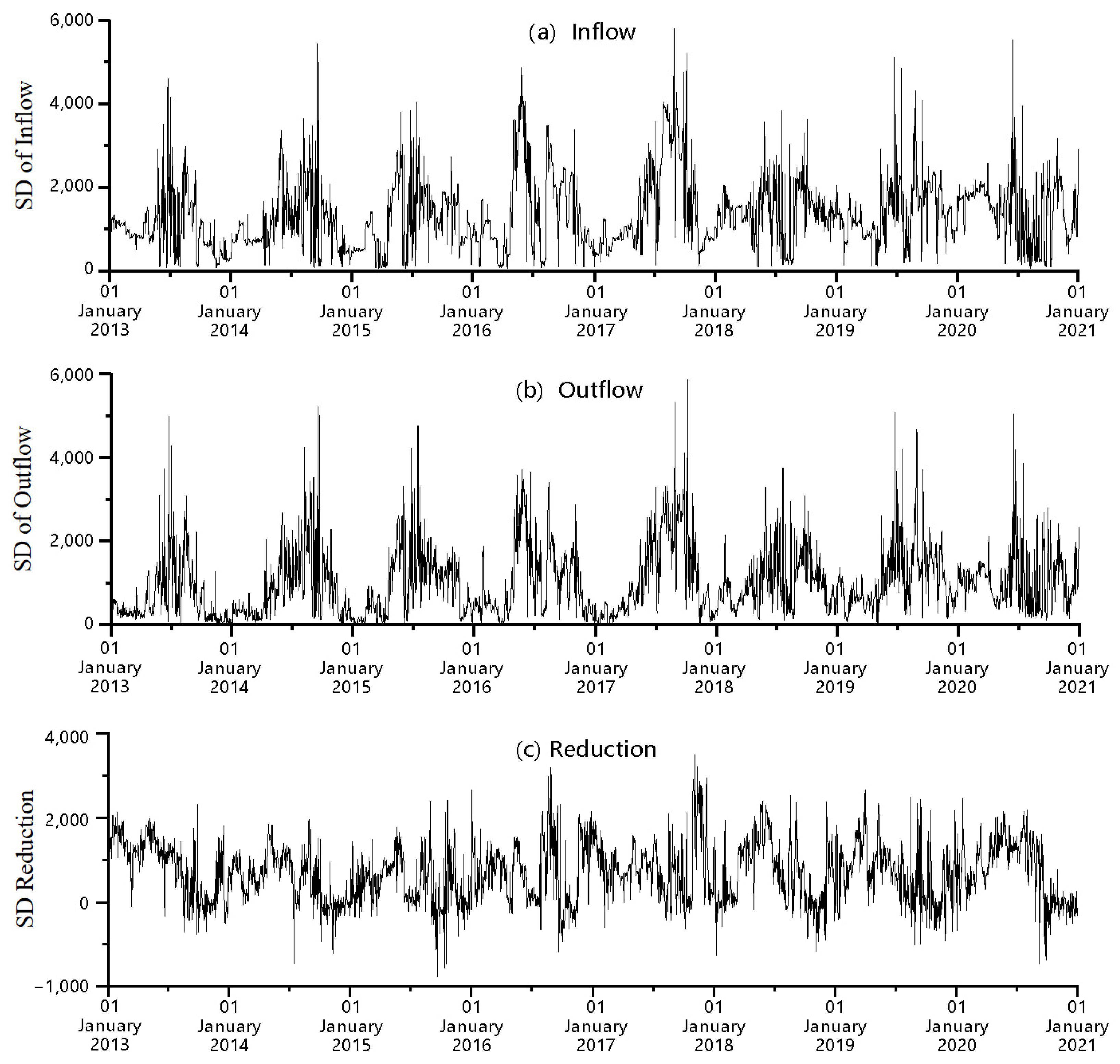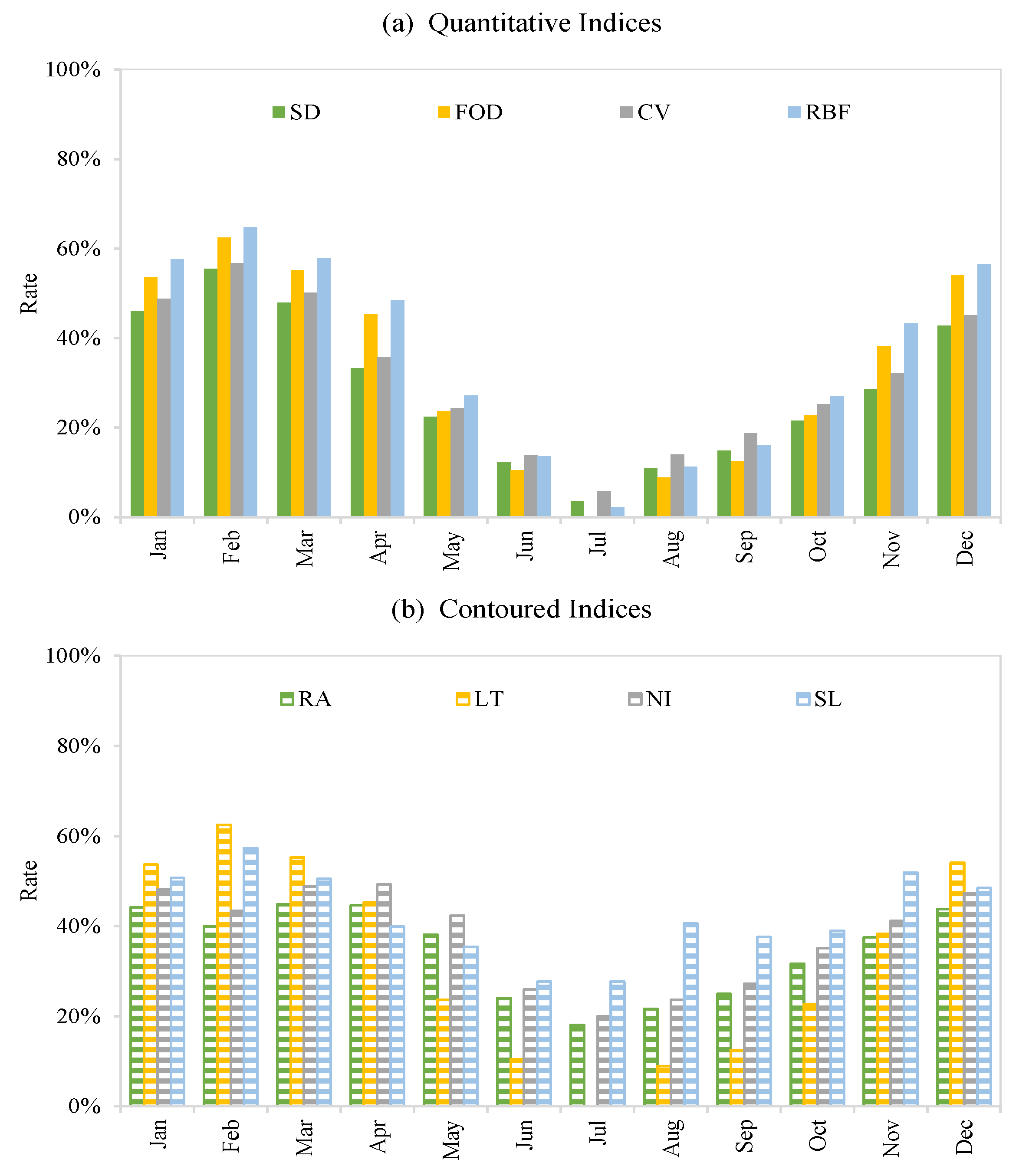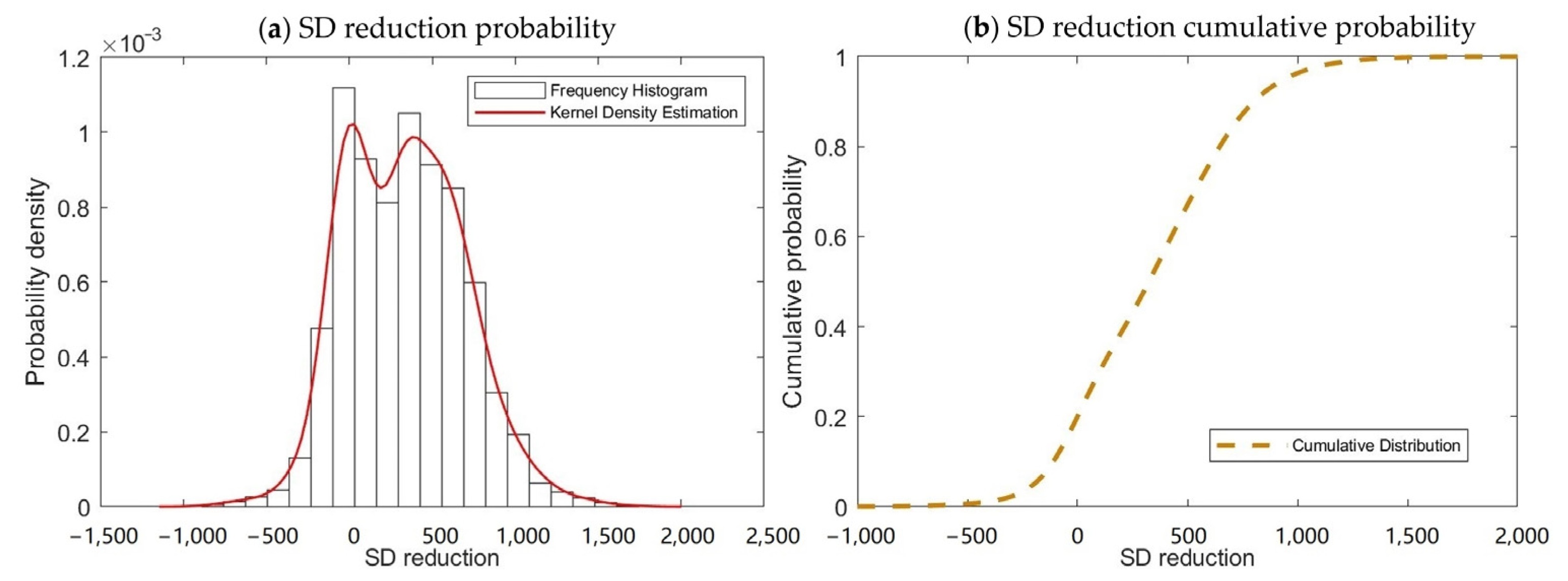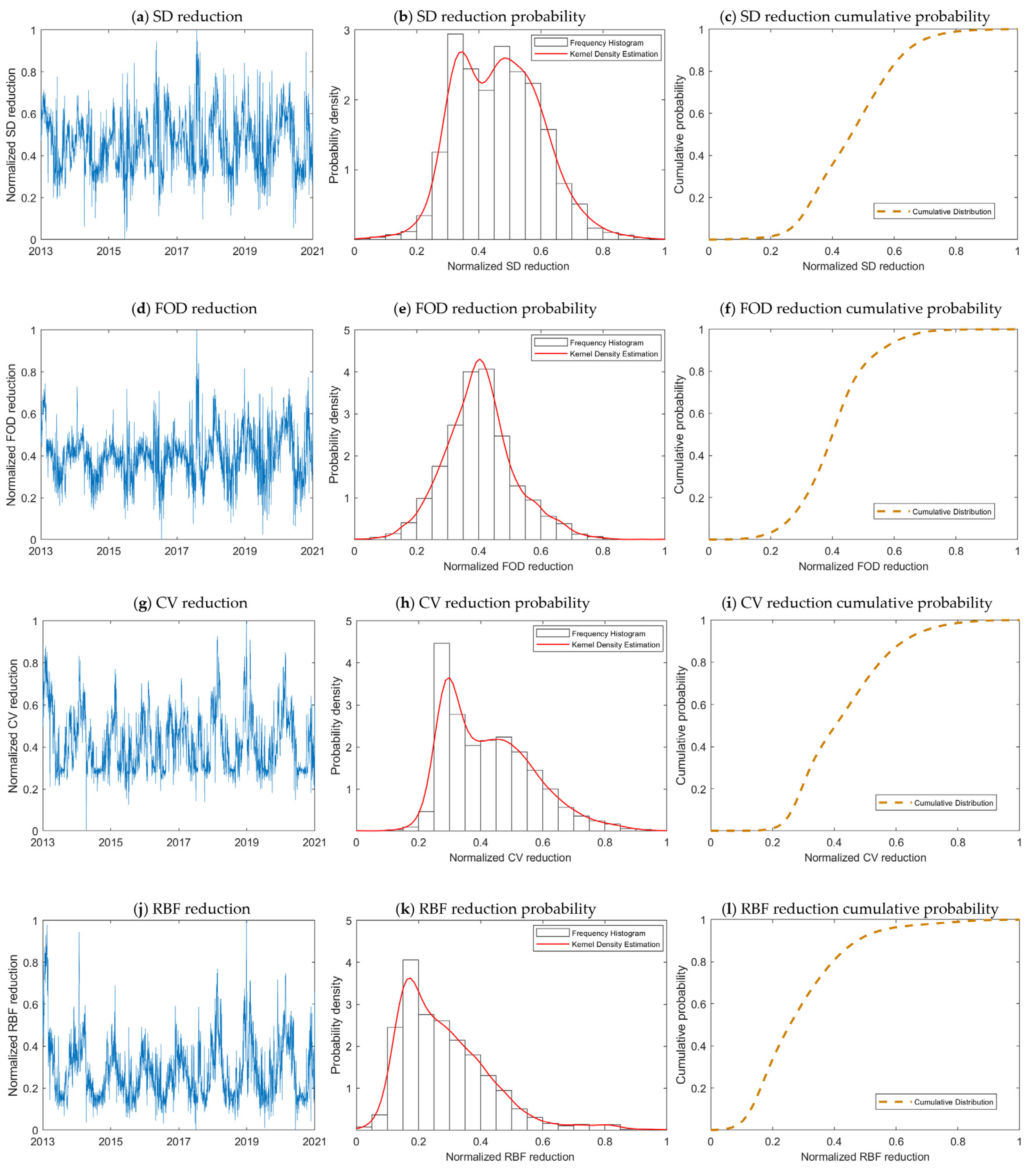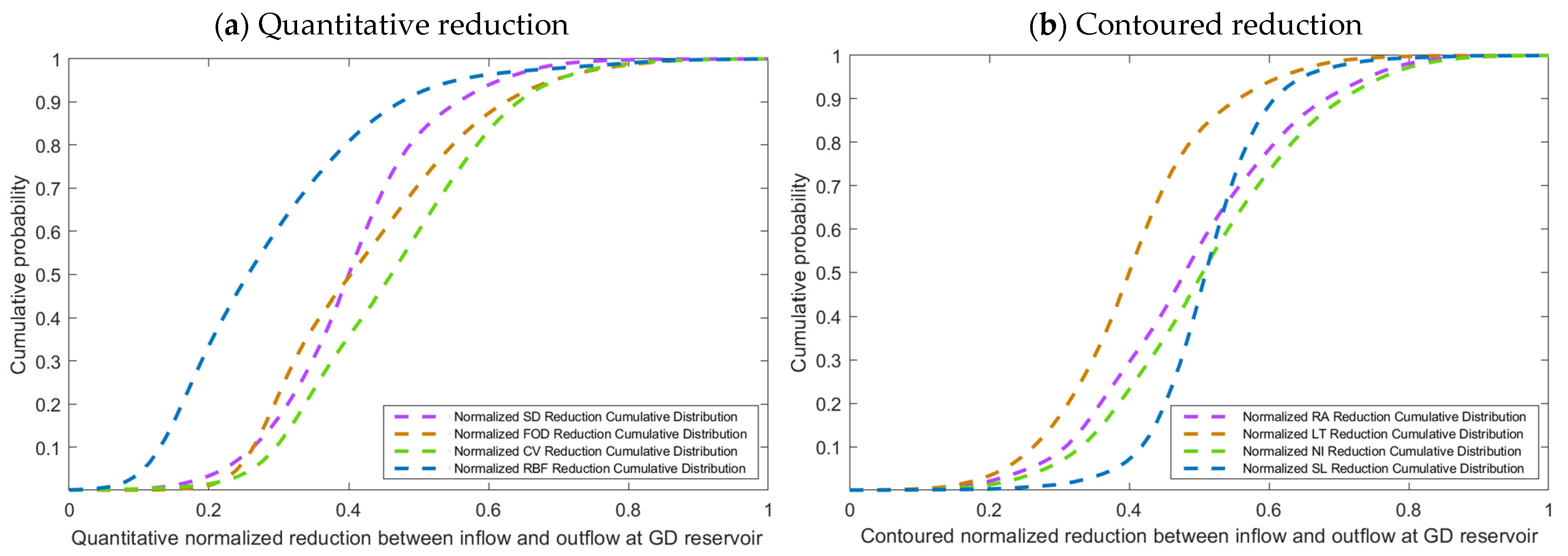1. Introduction
Reservoir facilities provide human access to water resources and induce environmental impacts by impeding the movement of aquatic organisms, changing the flow regimes, and altering the habitat [
1]. In addition to providing power production [
2], reservoir facilities also commonly fulfill other functions, such as flood mitigation [
3] and water supply [
4]. Given that the human requirement for water resources is usually regular, while the nature of river flow is random [
5], a trade-off between the human regulation of reservoirs and the natural flow regime is inevitable. In recent decades, natural and anthropogenic modifications to climate drivers, in conjunction with landscape changes, have led to increasingly nonstationary flow regimes [
6]. As the hydrological regime of a river can strongly influence aquatic ecosystems, human-induced changes in the river regime can threaten the structure and sustainability of aquatic communities [
7]. Fortunately, re-regulation, understood in this study as the buffer capacity to temporarily store and discharge the water flow, is an effective way to alleviate alterations in the river flow regime caused by reservoir regulation [
8]. This study aimed to assess the effect of re-regulation on alleviating the flow regime alteration caused by an up-cascade reservoir.
The more frequent the reservoir regulation, the more severe the alteration to the river flow. Consequently, further re-regulation could be needed to alleviate the disturbance to the river flow regime. The ecosystem impact and the re-regulation operation are affected by the combined action of climate variability and the management of upstream reservoirs [
9]. With various regulation patterns of the reservoir (e.g., flood mitigation or power generation) or under different hydrological conditions (e.g., high- and low-flow), the abovementioned reaction changes. For the sake of adequately balancing the disturbed river flow via re-regulation, it is necessary to study the re-regulation mechanism of reservoirs.
As the third longest and ninth largest river on Earth, the Yangtze River serves as a link between nature and humans in China [
10]. Upstream of the Yangtze River, there are at least 19,426 reservoirs with ~190 GW installed capacity [
11]. The Three Gorges Dam (TGD) and Gezhouba Dam (GD) hydro-system is the largest and last hydro-junction in the Yangtze River. The TGD, as the up-cascade in the hydro-junction, dispatches the water flow as required to accomplish anthropogenic water uses (e.g., power generation, shipping, and water resource utilization [
12]), while the GD, the down-cascade, is assigned to re-regulating the disturbed outflow of the TGD (i.e., alleviate the river flow fluctuation) in order to guarantee shipping flow safety and to protect the ecosystem while ensuring power generation stays within the desired ranges. The flow regime alteration and alleviation at the TGD–GD hydro-junction adequately represents the trade-offs between water use and environmental protection.
The impact of the TGD–GD hydro-junction on the hydrological regime (e.g., sediment, habitats, and streamflow) has been investigated before. Conducting a sediment budget analysis, Yang et al. [
13] pointed out that, influenced by the TGD, significant erosion occurred in the downstream riverbed and led to a conversion from progradation to recession in the delta front. When assessing river habitats, the effects of dam construction on the spawning grounds of Chinese Sturgeon in the TGD are more apparent than those in the GD [
14]. A multifractal detrended analysis of a long, daily streamflow series found that the streamflow fluctuated less after the construction of the GD [
15]. Wang et al. [
16] pointed out that the main driver of decadal lake decline across the Yangtze Plain is climate variability, not TGD regulation. Recently, a number of large reservoir clusters (including the TGD and GD) have been built upstream of the Yangtze River. The results of the study on cascaded dam development on the natural flow in the Yangtze River upstream indicated that the gap between the low- and high-flow decreases due to more reservoirs being brought into service, while the minimum and optimal ecological flow cannot be guaranteed during the fish spawning period [
17].
As aforementioned, the GD is assigned to re-regulate the outflow of the TGD. With limited storage capacity, the GD is mostly simplified as a run-of-river hydropower facility that does not alter the river flow. However, in real operation, the GD functions persistently, especially in the intra-day range (mainly on the hourly scale). Reflecting on the real-life operation yields, some interesting questions arise: is it appropriate to ignore the re-regulation function of the down-cascade because of its small storage capacity? What is the long-term effect of the intra-day re-regulation on alleviating the flow regime alteration? To the best of our knowledge, the answers to these questions have not yet been thoroughly examined. Aiming at these problems, this study endeavors to assess the GD re-regulation effect on the flow regime alteration induced by the TGD, examining eight years of hourly data resulting from the real operation of the TGD–GD hydro-junction.
The main conclusions of this work are: (1) the re-regulation at the GD is noticeable at the hourly scale; (2) the contoured fluctuation is alleviated more than the quantitative fluctuation; and (3) re-regulation also partially causes perturbations on the power output. The remainder of this paper is organized as follows.
Section 2 presents a description of the methods used to assess the fluctuation.
Section 3 introduces a description of the case study.
Section 4 and
Section 5 describe the results, discussion, and conclusions of the study.
2. Methods
In order to assess the re-regulation effect on the flow regime, it is necessary to characterize the river flow fluctuation. A number of indices have been proposed throughout the last few decades that are useful for this purpose, including the Indicators of Hydrological Alteration (IHA, [
18]), the Range of Variability Approach (RVA, [
19]), the Richards–Baker Flashiness Index (RBF, [
20]), and eco-flow metrics [
21], among others. These indices can be classified into quantitative and contour [
22]. The former is focused on the ordinate values, without counting the time element (i.e., the abscissa values), in terms of the first-order difference [
23], peak valley difference [
24], standard deviation [
25], coefficient of variation [
26], normalized standard deviation [
27], or their combination [
28]. The quantitative type does not commonly characterize the horizontal fluctuation due to neglecting the abscissa value of the fluctuant process. For example, the standard deviation values of two identical sinusoidal processes, but with different periods (e.g., one is 1 PI, the other is 2 PI), are almost the same; however, it is obvious that the one with a shorter period is more fluctuant. The latter—that is, the contour indices—takes the time element into consideration and mainly describes the shape of the process, such as its slope [
29], rotation angle [
30], or length [
31]. The contoured type does count the horizontal fluctuation, but its calculation formula is complex; thus, it is usually employed when the variation rate or the shape of the process is concerned.
More recently, the Mei–Wang Fluctuation (MWF) index was introduced, compounding the standard deviation and rotation angle to detect the quantitative and contour variations simultaneously [
22]. The MWF index has been applied in characterizing fluctuations in the power output in multi-renewable energy integration [
32,
33] and the variations in the flow regime in a rainfall-driven river [
34]. In terms of the methods to quantify the fluctuation, the advantage is that the previous studies have proposed many indices, while the shortcoming is also apparent, which is that most studies only employ or propose one index to quantify the fluctuation.
This paper uses eight commonly used fluctuation indices, and based on hourly measured operation data, investigates the alleviation effect of reservoir re-regulation on the river flow regime. The four quantitative type indices used in the study are: standard deviation (SD, depicting the dispersion), the first-order difference (FOD, depicting the difference of adjacent points), the coefficient of variation (CV, depicting the relative dispersion), and the Richard-Baker Flashiness (RBF, depicting the relative difference of adjacent points). The four contoured-type indices used in the study are: rotation angle (RA, depicting the change of variation tendence), length (LT, depicting the length of variation process), number of inflection (NI, depicting the switch number of variation direction), and slope (SL, depicting the rate of variation change). It should be noted that there are no strict selection criteria for determining the abovementioned indices.
Taking the time series with the coordinates of N points (
xi,
yi) as an example, the functions of the eight indices above are introduced in
Table 1 and
Table 2. It should be noted that the number of the points is
N, the abscissa of the time series is time, and 1 unit of abscissa means 1 day.
To formulate the process of calculating the fluctuation of the river flow, a model is built as follows:
where F is the model output corresponding to the river flow fluctuation (e.g., the symbols listed in
Table 1 and
Table 2),
f (•) is the functions applied to calculate the fluctuation (as listed in
Table 1 and
Table 2), and • is the input of this model, corresponding to the coordinates where the river flow will be evaluated.
The process of calculating the river flow fluctuation is shown in
Figure 1.
- (1)
Quantitative type
The functions of SD, FOD, CV, and RBF are shown in
Table 1.
- (2)
Contoured type
The functions of RA, LT, NI, and SL are shown in
Table 2.
- (3)
Calculating the river flow fluctuation
Using the hourly river flow in one day (displayed in
Figure 2) as an example, and the value of (
xi,
yi) listed in
Table 3, the fluctuation values of the river flow in
Figure 2 are calculated and shown in
Table 4.
River flow fluctuation is calculated based on the data of the river flow and the functions listed in
Table 3.
3. Case Study
This work examines the TGD-GD hydro-junction as a case study to assess the alleviation of the down-cascade re-regulation on the flow regime alteration induced by an up-cascade reservoir. The TGD–GD hydro-junction is located upstream of the Yangtze River, as shown in
Figure 3. Many features of this hydro-junction are among the top in the world, including its reservoir size (39.3 × 10
9 m
3), installed capacity (22.5 GW), sluice gates (102,500 m
3/s discharge ability), ship lift (113 m elevation range), and lock (double-line five-grade). To assure the safety of shipping and the protection of the ecosystem downstream of the TGD–GD hydro-junction, the GD is used as a re-regulation facility. Limited by its re-regulation storage capacity, which is only 0.11 × 10
9 m
3, the period of re-regulation at the GD reservoir is within 1 day. The purpose of this re-regulation is to smooth the fluctuant outflow from the TGD.
The conservation storage capacity (i.e., water typically stored or withdrawn for beneficial uses [
35]) of the TGD reservoir is 22.15 × 10
9 m
3 (i.e., storage between the normal pool level, 175 m, and the dead water level, 145 m). For the GD reservoir, its conservation storage capacity is 0.11 × 10
9 m
3, its normal pool level is 66 m, and its dead water level is 62 m.
In this study, we use hourly measured operation data from 1 January 2013 to 31 December 2020, such as the inflow, outflow, water level, power output, etc. These data are presented in
Appendix A. The hourly operation standardized process of the TDG–GD hydro-junction between 1 January 2013 0:00 and 31 December 2020 23:00, in terms of the inflow, outflow, power output, reservoir water level, and tailwater level, are displayed in
Figure A1,
Figure A2,
Figure A3,
Figure A4,
Figure A5 and
Figure A6. The inflow is calculated based on a water balance of the outflow and reservoir water level. The outflow is measured at the hydraulic equipment of the hydropower plant and floodgate. The reservoir water level is measured at the hydrological station located near the dam on the upstream side. The tailwater level is measured at the hydrological station located near the plant house.
5. Conclusions
A hydro-junction with dual cascades is a facility that can appropriately utilize water resources by altering the water flow at the up-cascade and alleviating the influence on the environment by smoothing the runoff fluctuation at the down-cascade. In this paper, we adopted eight commonly used indices to analyze the fluctuation of the inflow and outflow of the reservoir of the largest hydro-junction system, the TGD and GD cascades. The results of the study show that the TGD (i.e., the up-cascade) causes an apparent alteration to the river flow regime, while the GD (i.e., the down-cascade) smooths the altered runoff on an hourly scale. The detailed comparisons indicate that: (1) the fluctuation reduction shows a seasonal trend; (2) the quantitative indices are reduced by 25.09–41.35%, while the contoured indices are reduced by 29.33–41.52%, and the re-regulation is more functional in mitigating the contoured fluctuation, with 90% cumulative probability; (3) the reservoir’s re-regulation also induces various impacts on the power output fluctuation.
Further research could explore new methods to quantify the fluctuation (e.g., using different indices) while identifying trade-offs between the inclusion of specific indices. Additionally, exploring the relationship between reductions in the runoff fluctuation and increments in the power output should consider the impact of the water head and the allocation of power plans among hydro-plants in greater detail.
